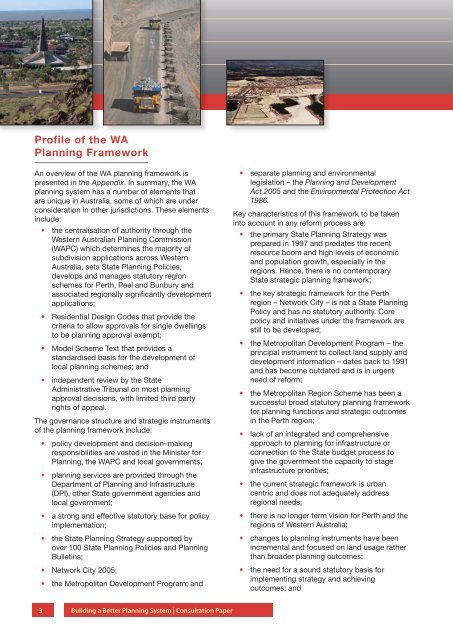Building a Better Planning System - Western Australian Planning ...
Building a Better Planning System - Western Australian Planning ...
Building a Better Planning System - Western Australian Planning ...
You also want an ePaper? Increase the reach of your titles
YUMPU automatically turns print PDFs into web optimized ePapers that Google loves.
Profile of the WA<br />
<strong>Planning</strong> Framework<br />
An overview of the WA planning framework is<br />
presented in the Appendix. In summary, the WA<br />
planning system has a number of elements that<br />
are unique in Australia, some of which are under<br />
consideration in other jurisdictions. These elements<br />
include:<br />
• the centralisation of authority through the<br />
<strong>Western</strong> <strong>Australian</strong> <strong>Planning</strong> Commission<br />
(WAPC) which determines the majority of<br />
subdivision applications across <strong>Western</strong><br />
Australia, sets State <strong>Planning</strong> Policies,<br />
develops and manages statutory region<br />
schemes for Perth, Peel and Bunbury and<br />
associated regionally significantly development<br />
applications;<br />
• Residential Design Codes that provide the<br />
criteria to allow approvals for single dwellings<br />
to be planning approval exempt;<br />
• Model Scheme Text that provides a<br />
standardised basis for the development of<br />
local planning schemes; and<br />
• independent review by the State<br />
Administrative Tribunal on most planning<br />
approval decisions, with limited third party<br />
rights of appeal.<br />
The governance structure and strategic instruments<br />
of the planning framework include:<br />
• policy development and decision–making<br />
responsibilities are vested in the Minister for<br />
<strong>Planning</strong>, the WAPC and local governments;<br />
• planning services are provided through the<br />
Department of <strong>Planning</strong> and Infrastructure<br />
(DPI), other State government agencies and<br />
local government;<br />
• a strong and effective statutory base for policy<br />
implementation;<br />
• the State <strong>Planning</strong> Strategy supported by<br />
over 100 State <strong>Planning</strong> Policies and <strong>Planning</strong><br />
Bulletins;<br />
• Network City 2005;<br />
• the Metropolitan Development Program; and<br />
• separate planning and environmental<br />
legislation – the <strong>Planning</strong> and Development<br />
Act 2005 and the Environmental Protection Act<br />
1986.<br />
Key characteristics of this framework to be taken<br />
into account in any reform process are:<br />
• the primary State <strong>Planning</strong> Strategy was<br />
prepared in 1997 and predates the recent<br />
resource boom and high levels of economic<br />
and population growth, especially in the<br />
regions. Hence, there is no contemporary<br />
State strategic planning framework;<br />
• the key strategic framework for the Perth<br />
region – Network City – is not a State <strong>Planning</strong><br />
Policy and has no statutory authority. Core<br />
policy and initiatives under the framework are<br />
still to be developed;<br />
• the Metropolitan Development Program – the<br />
principal instrument to collect land supply and<br />
development information – dates back to 1991<br />
and has become outdated and is in urgent<br />
need of reform;<br />
• the Metropolitan Region Scheme has been a<br />
successful broad statutory planning framework<br />
for planning functions and strategic outcomes<br />
in the Perth region;<br />
• lack of an integrated and comprehensive<br />
approach to planning for infrastructure or<br />
connection to the State budget process to<br />
give the government the capacity to stage<br />
infrastructure priorities;<br />
• the current strategic framework is urban<br />
centric and does not adequately address<br />
regional needs;<br />
• there is no longer term vision for Perth and the<br />
regions of <strong>Western</strong> Australia;<br />
• changes to planning instruments have been<br />
incremental and focused on land usage rather<br />
than broader planning outcomes;<br />
• the need for a sound statutory basis for<br />
implementing strategy and achieving<br />
outcomes; and<br />
3<br />
<strong>Building</strong> a <strong>Better</strong> <strong>Planning</strong> <strong>System</strong> | Consultation Paper

















